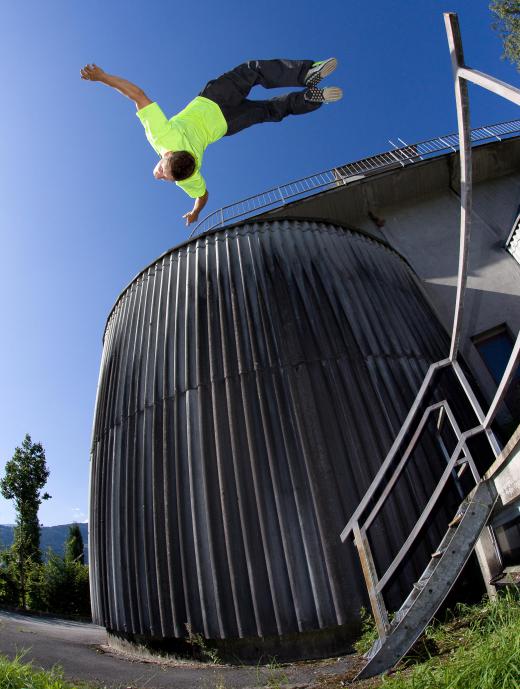One of the advantages of learning parkour, also known as free running, is that it requires no expensive equipment other than a good pair of running shoes. Parkour is a form of acrobatics that uses rural and urban settings as an obstacle course. Therefore, most of the equipment is already available, such as railings, walls and park benches. Some parkour athletes will want to purchase gear for strength training or safety gear such as elbow pads and knee pads, but much of it is optional.
The most important investment a person can make when beginning parkour is a suitable pair of shoes. Sneakers with good arch support will make it easier to both run long distances and make soft landings. The shoes should have soles that do not skid, because parkour sometimes requires climbing smooth walls. Beyond a good pair of shoes, any other material goods are completely optional for parkour.

Strength training and conditioning is crucial for athletes who wish to perform the intense acrobatics of parkour. Some might consider regular gym equipment as a form of parkour gear, because it helps to prepare for the real playing field, which is the urban obstacle course located outside. Working out at a gym is not always necessary, however. The philosophy of parkour is to find one’s own way, and many parkour enthusiasts do their strength training on the very outdoor rails and walls over which they enjoy leaping and climbing.

Some athletes like to create a controlled replica of the urban jungle for parkour training. Indoor walls and railings can be erected for obstacle course training. Beginners might also wish to use safety parkour gear, such as elbow pads, knee pads and gymnastic mats, for injury-free landings. Some sporting goods manufacturers that specialize in extreme sports have begun offering more parkour gear that aids controlled training.

Athletes might wish to bring some entertainment along for the journey, making a durable and tightly secured digital music player a valued piece of parkour gear for some people. It is also recommended that water be kept nearby, because dehydration can occur during heavy workouts. Although it isn't practical to carry much at all on the body while practicing parkour, a nearby meeting ground or storage locker should have a first aid kit inside. Minor scrapes and bruises are par for the course, and it is always a good idea to keep any wounds clean.
